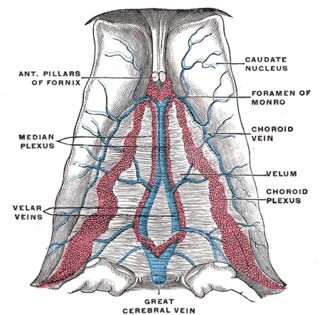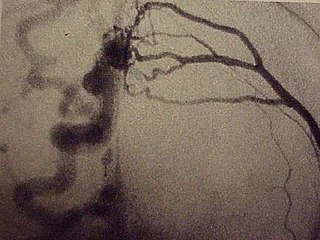
Conjoined twins, popularly referred to as Siamese twins, are twins joined in utero. It is a very rare phenomenon, estimated to occur in anywhere between one in 49,000 births to one in 189,000 births, with a somewhat higher incidence in Southwest Asia and Africa. Approximately half are stillborn, and an additional one-third die within 24 hours. Most live births are female, with a ratio of 3:1.

Craniopagus parasiticus is an extremely rare type of parasitic twinning occurring in about 2 to 3 of 5,000,000 births. In craniopagus parasiticus, a parasitic twin head with an undeveloped body is attached to the head of a developed twin. Fewer than a dozen cases of this type of conjoined twin have been documented in literature.

In neuroanatomy, dura mater is a thick membrane made of dense irregular connective tissue that surrounds the brain and spinal cord. It is the outermost of the three layers of membrane called the meninges that protect the central nervous system. The other two meningeal layers are the arachnoid mater and the pia mater. It envelops the arachnoid mater, which is responsible for keeping in the cerebrospinal fluid. It is derived primarily from the neural crest cell population, with postnatal contributions of the paraxial mesoderm.

The great cerebral vein is one of the large blood vessels in the skull draining the cerebrum of the brain. It is also known as the vein of Galen, named for its discoverer, the Greek physician Galen.

Cerebral circulation is the movement of blood through a network of cerebral arteries and veins supplying the brain. The rate of cerebral blood flow in an adult human is typically 750 milliliters per minute, or about 15% of cardiac output. Arteries deliver oxygenated blood, glucose and other nutrients to the brain. Veins carry "used or spent" blood back to the heart, to remove carbon dioxide, lactic acid, and other metabolic products. The neurovascular unit regulates cerebral blood flow so that activated neurons can be supplied with energy in the right amount and at the right time. Because the brain would quickly suffer damage from any stoppage in blood supply, the cerebral circulatory system has safeguards including autoregulation of the blood vessels. The failure of these safeguards may result in a stroke. The volume of blood in circulation is called the cerebral blood flow. Sudden intense accelerations change the gravitational forces perceived by bodies and can severely impair cerebral circulation and normal functions to the point of becoming serious life-threatening conditions.

Intracranial hemorrhage (ICH), also known as intracranial bleed, is bleeding within the skull. Subtypes are intracerebral bleeds, subarachnoid bleeds, epidural bleeds, and subdural bleeds.
The emissary veins connect the extracranial venous system with the intracranial venous sinuses. They connect the veins outside the cranium to the venous sinuses inside the cranium. They drain from the scalp, through the skull, into the larger meningeal veins and dural venous sinuses. They may also connect to diploic veins within the skull.

The falx cerebri is a large, crescent-shaped fold of dura mater that descends vertically into the longitudinal fissure between the cerebral hemispheres of the human brain, separating the two hemispheres and supporting dural sinuses that provide venous and CSF drainage to the brain. It is attached to the crista galli anteriorly, and blends with the tentorium cerebelli posteriorly.
Clarence and Carl Aguirre are former conjoined twins born in Manila. They were conjoined at the top of the head and shared 8 centimetres (3.1 in) of brain. More than 1–2 centimetres (0.4–0.8 in) will affect brain functionality in one or both of twins. Without separation, they were expected to live around 6–8 months.

The confluence of sinuses, torcular Herophili, or torcula is the connecting point of the superior sagittal sinus, straight sinus, and occipital sinus. It is below the internal occipital protuberance of the skull. It drains venous blood from the brain into the transverse sinuses. It may be affected by arteriovenous fistulas, a thrombus, major trauma, or surgical damage, and may be imaged with many radiology techniques.

The superior sagittal sinus, within the human head, is an unpaired area along the attached margin of the falx cerebri. It allows blood to drain from the lateral aspects of anterior cerebral hemispheres to the confluence of sinuses. Cerebrospinal fluid drains through arachnoid granulations into the superior sagittal sinus and is returned to venous circulation.

The superior petrosal sinus is one of the dural venous sinuses located beneath the brain. It receives blood from the cavernous sinus and passes backward and laterally to drain into the transverse sinus. The sinus receives superior petrosal veins, some cerebellar veins, some inferior cerebral veins, and veins from the tympanic cavity. They may be affected by arteriovenous malformation or arteriovenous fistula, usually treated with surgery.

A dural arteriovenous fistula (DAVF) or malformation is an abnormal direct connection (fistula) between a meningeal artery and a meningeal vein or dural venous sinus.

The cerebellar veins are veins which drain the cerebellum. They consist of the superior cerebellar veins and the inferior cerebellar veins. The superior cerebellar veins drain to the straight sinus and the internal cerebral veins. The inferior cerebellar veins drain to the transverse sinus, the superior petrosal sinus, and the occipital sinus.
Krista and Tatiana Hogan are Canadians who are conjoined craniopagus twins. They are joined at the head and share a skull and a brain. They were born in Vancouver, British Columbia, and are the only unseparated conjoined twins of that type currently alive in Canada. They live with their mother, Felicia Simms, in Vernon, British Columbia, have two sisters and a brother and often travel to Vancouver for care at BC Children's Hospital and Sunny Hill Health Centre for Children.
Anastasia and Tatiana Dogaru are craniopagus conjoined twins. They were scheduled to begin the first of several surgeries to separate them at Rainbow Babies and Children's Medical Center in Cleveland, Ohio. However, in August 2007 the surgery was called off as too dangerous.
James Tait Goodrich was an American neurosurgeon. He was the director of the Division of Pediatric Neurosurgery at Montefiore Health System and Professor of Clinical Neurological Surgery, Pediatrics, Plastic and Reconstructive Surgery at the Albert Einstein College of Medicine, and gained worldwide recognition for performing multiple successful separations of conjoined twins. He assisted in two craniopagus separations with Dr. Alferayan A in Riyadh, Saudi Arabia, with the first one done May 5, 2014 and the second one done February 14, 2016. Both pairs were successfully separated and are doing well.
Dr Noor ul Owase Jeelani BMed.Sci (Hons), BMBS, MRCS, MBA, MPhil, FRCS (NeuroSurg.) is a Kashmiri-British neurosurgeon and academic. He is a Consultant Paediatric Neurosurgeon at Great Ormond Street Hospital for Children (GOSH) and was the Head of the Department of Neurosurgery from 2012 until 2018. He is an Honorary Associate Professor at the Institute of Child Health, University College London. He leads the FaceValue research group in Craniofacial Morphometrics, device design, and clinical outcomes.

András Csókay, is a Hungarian neurosurgeon with international recognition in the field of neurosurgery for his development of a technique to enhance microsurgical precision in the vascular tunnel and for the separation of a pair of Bangladeshi (Islam) Craniopagus Twins.

Cranial venous outflow obstruction, also referred to as impaired cranial venous outflow, impaired cerebral venous outflow, cerebral venous impairment is a vascular disorder that involves the impairment of venous drainage from the cerebral veins of the human brain.


















